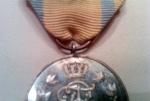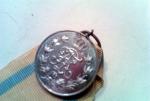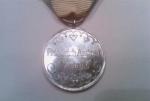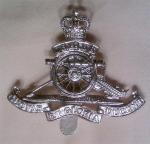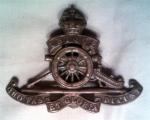-
Posts
5,629 -
Joined
-
Last visited
Content Type
Profiles
Forums
Blogs
Gallery
Events
Store
Everything posted by IrishGunner
-

Artillery piece for identification please
IrishGunner replied to coldstream's topic in Armour, Vehicles, Ships & Aircraft
This just sold on eBay for $12 (not to me); it looks like the same battery position. And those are German soldiers. I think at least we can narrow this down to a German gun position armed with at least 10cm naval ordnance. But no chain in this photo... -

Soviet Chernobyl Liquidators Medals
IrishGunner replied to canutt's topic in USSR: Soviet Orders, Medals & Decorations
Haven't seen the one on the left. The one on the right is a badge: "Participant in the Liquidation of Effects of the Accident at the ChAES (Chernobyl Nuclear Power Plant)" This was awarded to volunteers who went into the radioactive zone to clean up the Chernobyl nuclear accident in 1986. I've seen a lot of these in flea markets in Eastern Europe for a few dollars. They sell for way too much on internet sites in my opinion. Considering events in Japan, there may be increased interest in these currently. -

Artillery piece for identification please
IrishGunner replied to coldstream's topic in Armour, Vehicles, Ships & Aircraft
Who says it's going to the side? I say that it's going to the side. Quite frankly, as a gunner, there is absolutely no theory to me that acceptably explains why a chain is being run down the tube. Mervyn is right; this is a war-time field expedient method for something. And to be disciplined enough to care about a clean tube would argue against being stupid enough to use a chain to do the cleaning. So, if one had to use a field expedient method, it had better be something important enough to risk damaging the tube. To me, that is pulling it out of battery to perform some kind of necessary maintenance to be able to make the gun ready to fire. A simple cleaning isn't that important. Of course, I'm applying my standards as a modern gunner; they could have been quite different in those days. And my standards might be different than other gunners. -

Artillery piece for identification please
IrishGunner replied to coldstream's topic in Armour, Vehicles, Ships & Aircraft
So, far the only theory that has come up on the other forum is the "cleaning" theory. And I just can't get on board with that one... Why is the chain taut going to the side if they are simply cleaning the gun? Wouldn't it be pulled straight out? And if it's being pulled, why not show the soldiers pulling instead of the barrel and no one? Of course, cleaning the tube remains a plausible theory, I just don't think likely. -

Artillery piece for identification please
IrishGunner replied to coldstream's topic in Armour, Vehicles, Ships & Aircraft
Don't feel bad; I have a few in that pile - well at least a pile that I'm not 100% sure of. :rolleyes: -

Artillery piece for identification please
IrishGunner replied to coldstream's topic in Armour, Vehicles, Ships & Aircraft
You know it just occurred to me that back when I still served in a gun battery, we would use a chain (often attached to a crane in the maintenance shop or a 5-ton wrecker in the field) wrapped around the outside of tube in order to pull it "out of battery" (out of its normal firing position which would release pressure on the recoil system) and hold the tube up in order to perform maintenance on the hydraulic recoil system. Of course, again we wrapped the chain on the outside the tube (to prevent tube damage) and it would not slip off because of the muzzle brake. The gun in the picture likely has a recoil system and the chain could be related to a maintenance procedure. As the tube has no muzzle break, they would need to attach a chain differently. To be this taut, I would think the chain is running down the tube and is connected to something at the breech end. Of course, since it's in the field and not a depot, they would have to use a field expedient method that would not be normally used. Like putting a chain down the barrel. Also, might explain why the "plate" propped on the front of the bunker has been removed from the gun and has been put out of the way while they perform some type of maintenance. The maintenance theory is the only thing that makes sense to me now. -

Artillery piece for identification please
IrishGunner replied to coldstream's topic in Armour, Vehicles, Ships & Aircraft
An attempt to damage the gun before capture. Hmm? An interesting theory, but it would take a lot of effort with a chain in the barrel. Smashing breech blocks (or simply removing the block) are easier and thus more common method. As for the splayed barrels; those are the result a weakened gun tube from excessive wear (because some idiot repeatedly put a chain down the barrel?) caused from repeated and heavy firing of the weapon or because of a flaw in the tube from manufacturer that eventually gives because of the constant pressure. They were common on both sides of the trenches; but the photos you see most often are German guns. In German: rohrkrepiehrer (sp?) which you often see written on the photo. -

Artillery piece for identification please
IrishGunner replied to coldstream's topic in Armour, Vehicles, Ships & Aircraft
Simon, I wondered about the capture part too; but the "bunker" is really just a screen; there does not seem to be a solid backside to the bunker. They could pull the gun out from the other direction with no trouble. The tautness of the chain is the most troubling. If it were just hanging out of the barrel, the other theories would make more sense. -

Artillery piece for identification please
IrishGunner replied to coldstream's topic in Armour, Vehicles, Ships & Aircraft
I seriously doubt that the chain was used as you describe. As a gunner, I can't imagine gunners would have subjected the tube to the banging of a chain. The chain would have created nicks, scrapes, and other damage to the rifling of the barrel. While gunnery was still in development, there certainly was an understanding that tube wear had an impact on accuracy. The tube isn't that long to push through a long, extended rod with a bore brush; it's still done that way today. If they had to pull it through, more likely a rope would have been used rather than a chain. It's for these reasons that the chain makes no sense whatsoever to my mind. -
I have recently obtained a post card with a Feldpost stempel: K.u.K Überprüfungs-Kommision Innsbruck Anyone know what this entity might have done? I seem to have read somewhere that it might have been a body charged with overseeing conscription.
-

Artillery piece for identification please
IrishGunner replied to coldstream's topic in Armour, Vehicles, Ships & Aircraft
Wow, Simon, this is a tough one. Sometimes its difficult to narrow down the model of a gun even when you can see the entire piece - there being variations and modifications. But I'll venture at least a couple guesses. I think this tube is less than 120mm. And possibly even a coastal defense gun converted for field use. There were some German coastal 10cm candidates, but without seeing the carriage it's difficult to say for sure. From my references, it looks most like the barrel of a British 4.7in QF field gun (which was a converted naval piece). But again, difficult to be sure. The bunker has more of a German look to it - to my eye anyway - than it does a British battery position. I've looked at many artillery photos and it just seems more like the German one's I've seen. So, that would point back to the Germans. Of course, a lot of fortress guns were pulled out and used by the Germans; so, it could be a fortress piece that is a bit odd and not in common references. The disc could indeed be part of the gun; a few had base plates upon which to traverse. Considering this piece is in a bunker with limited traverse, they just might not need it in this position. And the gunners figured that was a good place to put it out of the way. The chain is a real conundrum. And certainly is temporary since it would greatly hinder the exit of a shell and result in a blown barrel. Are you sure it's not just an optical illusion? Sorry, I can't add more than mere guesses. You could try posting it on the Landships forum. There are some particular keen cannon experts there that might give better answers. -

Royal Artillery badges
IrishGunner replied to IrishGunner's topic in Great Britain: Militaria: Badges, Uniforms & Equipment
Thanks for the assist Paul. -

Royal Artillery badges
IrishGunner replied to IrishGunner's topic in Great Britain: Militaria: Badges, Uniforms & Equipment
Around WW2 it became cloth, but I don't think it is still used as part of the rank insignia for sergeants. I understand that it is, however, still worn by Master Gunners. -

Royal Artillery badges
IrishGunner replied to IrishGunner's topic in Great Britain: Militaria: Badges, Uniforms & Equipment
Frank, the crown-less one is a "gun badge". This is a sleeve badge worn above three chevrons as part of the rank insignia to designate a sergeant. It also can be worn by warrant officers on their sleeves to designate "Master Gunner". -

Royal Artillery badges
IrishGunner replied to IrishGunner's topic in Great Britain: Militaria: Badges, Uniforms & Equipment
In case, you are interested... (Waiting for Chris' comments... ) "THE CAP BADGE OF THE ROYAL REGIMENT OF ARTILLERY The gun badge for all members of the Royal Regiment of Artillery was introduced in 1902 to be worn in the Service Dress Cap by all ranks of the Regiment (Regular Army). The design of the badge derives from the Coat of Arms of the Royal Regiment of Artillery which was granted to the Regiment in July 1832 by His Majesty King William IV. The Royal arms and supporters with a cannon and the motto "Ubique quo fas et gloria du######". This was amended in 1833 to "Ubique" and "Quo fas et gloria du######", which translates to "Everywhere" and "Whither right and glory lead". The gun used is said to be a Smooth Bored Muzzle Loading 9 pounder with a wooden trail, the trail was changed to steel in 1872. The gun badge has both mottoes of the Regiment UBIQUE (EVERYWHERE) on the upper scroll and QUO FAS ET GLORIA DU###### (WITHER RIGHT AND GLORY LEAD) on the lower scroll. A modified design was worn by members of the Territorial Force (laurel spray replaced UBIQUE) and the Volunteers (the word VOLUNTEERS replaced UBIQUE). It was made in brass for Soldiers, also bronze and gilt with a raised wheel for Officers. The Bronze version is worn on the Service Dress Cap and on the flap of a brown leather pouch attached to a brown leather shoulder belt worn by Officers in Service Dress. The Gilt version is worn on the Number 1 Dress Cap and on the flap of a black leather pouch attached to a shoulder belt worn by Officers in some forms of dress. A plastic version was produced during World War 2 for wear by Other Ranks on the Cap General Service (a large khaki gabardine beret). A brass version with a revolving raised wheel was produced privately for sale through the canteens, the Royal Artillery Association sells a similar version in anodised aluminium. In 1954 the crown was changed to the St. Edward's Crown. Marc J Sherriff © April 1997" (re-copied from Great War Forum) -

Royal Artillery badges
IrishGunner replied to IrishGunner's topic in Great Britain: Militaria: Badges, Uniforms & Equipment
-
It's a full Colonel of Artillery. I wanted something I could display with a bit of glitz and this fit the bill. But of course, only a Colonel of Artillery could give you that proper bit of glitz. Very nice; something of which to be proud. :cheers:
-

Austria-Hungary Tapferkeitsmedaille Karl
IrishGunner replied to pinpon590's topic in Austro-Hungarian Empire
The medal is stamped "BRONZE" Why would a silver medal be stamped "bronze"?




